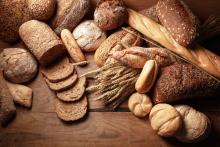, with accompanying changes in epithelial tight junction proteins and eosinophils.
Among 108 patients who completed the study, 61% showed this atypical allergic response to wheat, wrote Annette Fritscher-Ravens, MD, PhD, of University Hospital Schleswig-Holstein in Kiel, Germany, and her associates. Strikingly, almost 70% of patients with atypical food allergies to wheat, yeast, milk, soy, or egg white who eliminated these foods from their diets showed at least an 80% improvement in IBS symptoms after 3 months. These findings were published in Gastroenterology.
Confocal laser endomicroscopy (CLE) “permits real-time detection and quantification of changes in intestinal tissues and cells, including increases in intraepithelial lymphocytes and fluid extravasation through epithelial leaks,” the investigators wrote. This approach helps clinicians objectively detect and measure gastrointestinal pathology in response to specific foods, potentially freeing IBS patients from highly restrictive diets that ease symptoms but are hard to follow, and are not meant for long-term use.
For the study, the researchers enrolled patients meeting Rome III IBS criteria who tested negative for common food antigens on immunoglobulin E serology and skin tests. During endoscopy, each patient underwent sequential duodenal challenges with 20-mL suspensions of wheat, yeast, milk, soy, and egg white, followed by CLE with biopsy.
Among 108 patients who finished the study, 76 (70%) were CLE positive. They and their first-degree relatives were significantly more likely to have atopic disorders than were CLE-negative patients (P = .001). The most common allergen was wheat (61% of patients), followed by yeast (20%), milk (9%), soy (7%), and egg white (4%). Also, nine patients reacted to two of the tested food antigens.
Compared with CLE-negative patients or controls, CLE-positive patients also had significantly more intraepithelial lymphocytes (P = .001) and postchallenge expression of claudin-2 (P = .023), which contributes to tight junction permeability and is known to be upregulated in intestinal barrier dysfunction, IBS, and inflammatory bowel disease. Conversely, levels of the tight junction protein occludin were significantly lower in duodenal biopsies from CLE-positive patients versus controls (P = .022). “Levels of mRNAs encoding inflammatory cytokines were unchanged in duodenal tissues after CLE challenge, but eosinophil degranulation increased,” the researchers wrote.
In a double-blind, randomized, crossover study, patients then excluded from their diet the antigen to which they had tested positive or consumed a sham (placebo) diet that excluded only some foods containing the antigen, with a 2-week washout period in between. The CLE-positive patients showed a 70% average improvement in Francis IBS severity score after 3 months of the intervention diet and a 76% improvement at 6 months. Strikingly, 68% of CLE-positive patients showed at least an 80% improvement in symptoms, while only 4% did not respond at all.
“Since we do not observe a histological mast cell/basophil increase or activation, and [we] do not find increased mast cell mediators (tryptase) in the duodenal fluid after positive challenge, we assume a nonclassical or atypical food allergy as cause of the mucosal reaction observed by CLE,” the researchers wrote. Other immune cell parameters remained unchanged, but additional studies are needed to see if these changes are truly absent or occur later after challenge. The researchers are conducting murine studies of eosinophilic food allergy to shed more light on these nonclassical food allergies.
Funders included the Rashid Hussein Charity Trust, the German Research Foundation, and the Leibniz Foundation. The researchers reported having no conflicts of interest.
SOURCE: Fritscher-Ravens A et al. Gastroenterology. 2019 May 14. doi: 10.1053/j.gastro.2019.03.046.



